“It’s stupidity rather than courage to refuse to recognize danger when it is close upon you.”
In his last installment of The Memoirs of Sherlock Holmes, “The Final Problem,” Arthur Conan Doyle writes, “It’s stupidity rather than courage to refuse to recognize danger when it is close upon you.” The short story was published in 1893. 1893. 122 years ago. Guess what else was happening then… Thomas Edison was inventing things, the Chicago World’s Fair inspired a nation, and the first college basketball game was in the books. That was a long time ago, yet the words still find great relevancy in 2015.
Today, many American communities are built around architecture dating from the same era as Sherlock Holmes and his sidekick, Watson. It’s foolish though, to believe these landmarks, most of them anyway, are able to meet the standards of today’s users without careful, well-planned adaptations. Perhaps more foolish, is the growing tendency to abandon old buildings with the belief that new construction is a more powerful or cost-effective solution (1). Historic architecture has a way of capturing a community’s identity and spirit, and in such an authentic expression. Devoting time, resources, and thoughtfulness to adapting them for modern use is a more than worthwhile venture, and one which has the ability to enrich and enhance a community’s culture and longevity.
To demonstrate, consider Swallow Hall on the University of Missouri campus. Built in – you guessed it – 1893, it originally served as the School of Commerce then morphed into the Zoology and Geology Building before its present-day incarnation as the home of the Departments of Anthropology and Art History. Next spring, IAA will complete the meticulous reconstruction and transformation of the academic building in order to increase functionality and anticipate future pedagogy trends, all within the hallowed walls of one of the oldest buildings on campus. Three principal objectives guide this transformation.
SAFETY AND BRINGING UP TO CODE I The earliest known building code dates from the Code of Hammurabi (BCE 1772). Rules and guidelines are good, but few remain effective indefinitely. Most all, whether originating in ancient Mesopotamia or nineteenth-century Missouri, require updating. In order for Swallow Hall to be functional, as well as safe, several improvements will be made including the the installation of a new elevator and fire safety system.
MODERNIZATION THROUGH DESIGN AND TECHNOLOGY I Smart, interactive, experiential, immersive, customized – all attributes of academic spaces of the fast-approaching future. Swallow Hall will align with this trend and be defined by a series of mixed-use areas promoting discussion, experiential learning, interdisciplinary curricula, and collaboration. Integrated lecture halls; adaptable offices, labs and seminar rooms; and flexible meeting spaces will equip students with a range of resources and platforms for intellectual exploration, both in and outside of organized lectures.
PRESERVATION OF HISTORICAL INTEGRITY I The saying “never judge a book by its cover” seems appropriate. Swallow Hall’s entire wooden interior structure will be removed and reconstructed with a cast-in-place concrete one, ensuring stability and longevity. In contrast to a completely modern inside, the original, brick masonry exterior envelope will be reinforced and remain, along with any architectural elements, preserving the hall’s character and cultural presence. The updated structure will remain eligible to be listed on the National Register of Historic Places despite extensive structural updates. (See the optimal approach illustrated here.)

When construction is complete, Swallow Hall will have 31 percent more usable space due to an updated programmatic scheme, a partially raised roof, and lowered subterranean floor. The nineteenth-century building will be LEED certified.
Demolishing historic structures can be culturally reckless. However, as Doyle thoughtfully expressed more than a century ago, it’s stupidity to refuse to recognize the inevitable. Ignoring the inefficiencies and even hazards of these landmarks is the refusal to acknowledge reality. There must be an artful fusion of old and new. If there is, countless communities will have the opportunity to embrace tradition while simultaneously cultivating centers of modernity in socially and environmentally responsible spaces.
————
1. Two residence halls on the University of Missouri campus each accommodate approximately the same amount of students (311 v. 312 beds). One, was newly constructed and opened in 2015, with a construction cost of $29.4M. The other was built in 1963 and renovated, reopening to the public in 2015. It’s construction cost was $18.2M. Each hall is LEED certified. (Figures from “Building Forward,” published in MIZZOU Magazine, May 20, 2015. [http://mizzoumag.missouri.edu/2015/05/building-forward/])